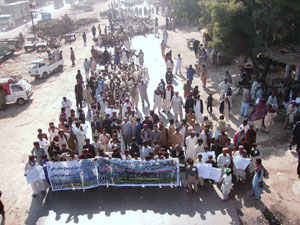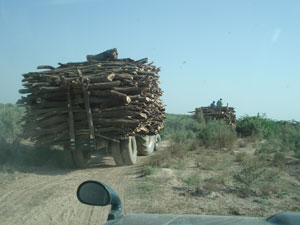The Shrinking Forests
By Salam Dharejo | News & Politics | Published 15 years ago
“We want to inform you that hundreds of people equipped with weapons and machinery, have surrounded Rais Mureed forest and started illegal cutting of trees. If immediate action is not taken, thousands of trees will be chopped off within a night.”
This was the text of an SMS circulated by the local volunteers of Forest Protection Committee that has been established by Indus Development Organisation to protect the Khebrani and Rais Mureed forests. Despite a ban on the cutting down of forests, Naveed Sama, a local landlord, with official support from Sharjeel Memon, head of the provincial Forest Anti-Encroachment Committee, established a camp of labourers and within two nights cleared 180 acres of forest land by chopping down 90,000 trees. When the forest department failed to take action, hundreds of local villagers came out to resist this wholesale slaughter of trees. Following a heavy exchange of fire, the villagers succeeded in saving the rest of the forest from land grabbers.
The Khebrani and Rais Mureed forests comprising 6000 acres in Matiari district, are being depleted as a consequence of the illegal encroachments on forest land. For the last three years, villagers have been fighting against the local landlords in order to preserve the green tract that provides livelihood to thousands of communities dwelling in the area. “To conserve the forests, the local community has started an organised social movement against the land grabbers,” says Zain Daudpoto, head of Indus Development Organisation. Interestingly, besides the conventional demonstrations, for the first time in the country’s history, a cattle rally comprising hundreds of goats and buffaloes was organised to protest against deforestation. Animals and men blocked the national highway and slogans such as, “We are uniting to protect the forests,” were raised.
Sindh covers an area of 14.1 million hectares comprising 18 per cent of the country’s total land mass. Due to its predominantly arid condition, the forest resources of Sindh (excluding the mangroves and grasslands) are very limited. They cover only 2.3 per cent of the total land area of the province. According to a study by the Sindh Forest Department, the riverine forests of Sindh, comprising 241,000 hectares that grow mostly along the river Indus in the flood plains, are vanishing rapidly. The report reveals that 60 to 70 per cent of these forests have deteriorated to a point where they no longer provide timber, fuel wood or fodder.
 Deforestation poses a potential threat to the environment and the ecosystem of Sindh. As a consequence of political interventions, the corruption of forest officials, and the nexus between land grabbers and the timber mafia over the last 25 years, the riverine forests of Sindh are on the verge of extinction. Additionally, natural causes related to climate change, shortage of water, population growth and water logging, plus illegal encroachments, illicit wood-cutting and lack of sustainable forest management have all affected the growth and development of forests in the province.
Deforestation poses a potential threat to the environment and the ecosystem of Sindh. As a consequence of political interventions, the corruption of forest officials, and the nexus between land grabbers and the timber mafia over the last 25 years, the riverine forests of Sindh are on the verge of extinction. Additionally, natural causes related to climate change, shortage of water, population growth and water logging, plus illegal encroachments, illicit wood-cutting and lack of sustainable forest management have all affected the growth and development of forests in the province.
Moreover, these forests have been ruthlessly exploited by the law enforcement agencies, politicians and bureaucrats for their own vested interests. According to a study conducted by the World Wildlife Fund (WWF)-Pakistan, “The riverine ecosystem upstream Sukkur and downstream Kotri-2008,” the degradation of riverine forests has been accelerated mainly due to the encroachment on more than 40,000 hectares of riverine forests by land grabbers.
It is a well known fact that influential landlords and political families control all forest land from Ghotki to Thatta district. In the upper part of the province, the Mahar families of Ghotki and Shikarpur, Mumtaz Bhutto and the Unar family of Larkana, the Jatoi family of Shikarpur and Dadu and the Shirazis in Thatta district, who have been in top positions in successive governments, have established their fiefdom called Keti. It is spread over the thousands of acres of forest land.
In 2009, the Sindh Public Accounts Committee (PAC) took notice of the encroachments on forest land and the secretary forests was summoned to provide a detailed report on the issue. The official disclosed that 39,710 acres of forest land was occupied by influential landlords. Responding to the query, the secretary informed the committee that the encroached land of the forest department could not be vacated till a joint operation of the Rangers and police was launched. He also disclosed that some members of the national and provincial assemblies and other political leaders were involved in the encroachment and grabbing of land.
“Control over forest land plays a pivotal role in the country’s power politics,” says Ishaque Mangrio, a political analyst. “The forest land is used by landlords to keep the voters employed as tenants and, further, to exercise control over criminals by providing them a safe hiding place. The majority of criminals living in the forests are provided protection by the local landlords.”
Politicians aside, law enforcement agencies have unwillingly contributed to the depletion of forests. Since the ’80s, several massive anti-dacoit operations have been launched by both the army and police, mostly in the riverine forest area which has continued to serve as a sanctuary for criminals. However, in virtually every operation, forests were set on fire to flush out the criminals from their hideouts. Moreover, to keep a close watch on dacoits, the police was given permission to establish stations inside the forests. And using their authority, the policeman resorted to taking bribes from the timber mafia and the land grabbers in return for allowing them to fell trees and use the land for agricultural production. Consequently, thousands of acres of forests were turned into wasteland and encroached upon by local landlords.
Massive corruption from top to bottom in the forest department has also played a pivotal role in the degradation of the riverine forests in Sindh. The Sindh Forestry Department, with financial assistance from the Asian Development Bank, initiated a seven-year “project for the improvement of the forest resource base on state and private land” in 1991-92 that was extended up to June 2001. The total cost of the project was estimated at Rs.1108.263 million. The purpose of the project was the rehabilitation and reforestation of 17 riverine and inland forests of Sindh. Due to massive corruption and poor management the project could not yield expected results. Ten years after the completion of the project, from Kashmore to Karachi on both sides of the River Indus, not a single fresh forest can be found. “The reforestation exists only on paper, while on the ground you will find ruthless deforestation,” says an employee of the forest department on condition of anonymity.
 The issue of corruption in the forest department has never been seriously addressed. And huge financial irregularities have remained unchecked. Shahid Hussain Ghumro, a retired employee of the forest department, has been knocking at every door, demanding accountability. “Since the last 10 years, I have been consistently writing to all institutions and heads of various departments about the rampant corruption in the forest department. I have all the evidence to prove that multimillion-rupee corruption that has taken place in the department.” He places bundles of documents before me as evidence of all the corruption in the forest department of Sukkur Division.
The issue of corruption in the forest department has never been seriously addressed. And huge financial irregularities have remained unchecked. Shahid Hussain Ghumro, a retired employee of the forest department, has been knocking at every door, demanding accountability. “Since the last 10 years, I have been consistently writing to all institutions and heads of various departments about the rampant corruption in the forest department. I have all the evidence to prove that multimillion-rupee corruption that has taken place in the department.” He places bundles of documents before me as evidence of all the corruption in the forest department of Sukkur Division.
On the basis of the charges levelled by Ghumro against 17 officials of the Sindh Forest Department, the National Accountability Bureau (NAB) initiated an enquiry against the then secretary, along with three conservators, for their alleged involvement in corruption, mismanagement and misuse of power in the Sukkur Forest Division. An investigation was carried out by Col. Tousif Ahmed between February 23 and April 26, 2003. In his enquiry report, the NAB official wrote that “during the field checking and on the basis of the record, it was discovered that there has been large scale unofficial harvesting of old growth trees standing over 5000 acres, worth rupees 25.851 million, by the higher officers of the forest department, as alleged in Ghumro’s complaint.”
Other than unofficial harvesting, the officers were also involved in unauthorised wood-cutting and issuing of unauthorised passes for the transportation of forest wood and disposal of government machinery. “I have ample evidence to prove that in Sukkur Forest Division alone, 80 million rupees were embezzled by high officials. But, despite the NAB probe, not a single officer was punished, and many of them continue to work in the department,” says Shahid Ghumro.
Despite the challenges posed by climate change and environmental degradation to forests, the government has not prepared a comprehensive strategy to cope with the issue. In fact, its forest policies while focusing on forest conservation, even fails to make any provision for the livelihood of the local communities. Consequently, they felt that they had no stake in the preservation of the forests, which made it easier for land grabbers to take control of forest land.
Additionally, the riverine forests have suffered immensely due to the dual policies of the government. The revenue department has made several allotments of forest land to people under a land grant scheme. It is estimated that more than 10,000 hectares of forest land have been allotted by the revenue department to people, who are fronting for influential landlords. And what’s more, according to a reliable source, the present Sindh government is planning to start a third phase of allotment of land to landless women under a land distribution programme in the Kacha area, instead of the Pucca area. Under this scheme, while forest land will be granted by the revenue department, it will not be mandatory upon the land owner to grow trees on 25 per cent of the land in accordance with the Agro-Forest Policy 2004. As if it was not bad enough that the forest resources were limited, more deforestation is to be expected as a result of the policies of the officials.
“I have been born and brought up here,” says Ghulam Hussain Khoso, a resident of Khebrani forest. Over time I have seen the rapidly decreasing size of the green patches. I do not believe in the policies that have been formulated for forest conservation nor do I trust that the department will ever improve forest conditions. I would go so far as to say that the dacoits were better custodians of the forest than the forest department itself. The thick forests served as a hideout for the dacoits. Therefore, they protected them and did not allow anyone to destroy them.”


